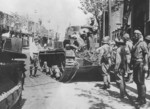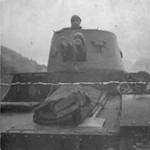6-Ton
| Country | United Kingdom |
| Manufacturer | Vickers-Armstrongs, Limited |
| Primary Role | Light Tank |
Contributor: C. Peter Chen
ww2dbaseThe Vickers 6-Ton light tanks, also known as Vickers Mark E, were designed by John Valentine Carden and Vivian Loyd in 1928 as a private project internal to Vickers. There were two variants, with Type A vehicles each having two machine gun turrets as the main armament, and Type B with a single turret with a short-barreled 47-millimeter OQF 3-pounder Gun. The British Army evaluated a prototype and rejected it. Failing to secure a domestic buyer, Vickers reached out to military forces abroad, ultimately signing contracts with Portugal, Finland, Poland, Bulgaria, Soviet Union, Greece, Thailand, Canada, Bolivia, and China.
ww2dbaseThe one Type A and two Type B vehicles purchased by Bolivia were the first tanks to see combat in the Americas as they participated in the Chaco War against Paraguay in 1933. 1 was destroyed, 1 was captured by Paraguay and sold to Spain, and the last was captured by Paraguay and became a monument. The monument vehicle was returned to Bolivia in 1994.
ww2dbaseChina purchased 20 Type B vehicles. They saw combat against the Japanese during the 1937 Second Battle of Shanghai.
ww2dbaseCanada purchased 12 Type B vehicles. They were assigned to the Canadian Armoured Fighting Vehicle School in 1938 and would never see combat.
ww2dbaseThe contract of Poland was for 50 vehicles, 38 (16 Type A and 22 Type B) of which would be put together (the remaining 12 were reserved for spare parts). These tanks had overheating issues, and the Polish Army modified them by adding larger air vents. The Polish 6-Ton tanks were also modified with the addition of Gundlach periscopes and two-way radios. Poland was generally, but not completely, satisfied with the Vickers 6-Ton design, thus it would purchase a license for local production; after modifications, it entered production as 7TP light tank. By the start of the European War in 1939, all of them were converted to single-turret tanks. These tanks served with the Polish 10th Cavalry Brigade during the 1939 German-Soviet joint invasion.
ww2dbaseThe Soviet Union was the first buyer, in 1931, of Vickers 6-Ton light tanks. It was generally satisfied with the 15 Vickers 6-Ton light tanks, but, like the Poles, it purchased a license for local production rather than purchasing additional examples. After modifications, it evolved into the T-26 design.
ww2dbaseFinland purchased 26 Type B vehicles, all of which arrived unarmed. They were armed in Finland with 37-millimeter Puteaux guns and 37-millimeter Bofors anti-tank guns. 13 of them saw combat. In 1941, the Finns rearmed the surviving 19 6-ton tanks to match that of captured Soviet T-26 tanks, and operated the two similar types together in the same unit during the Continuation War and beyond. They were retired together in 1959.
ww2dbaseThailand purchased 30 Type B vehicles. They saw combat during the 1940-1941 Franco-Thai War.
ww2dbaseDuring the design's production life time, 153 examples of Vickers 6-Ton light tanks were built.
ww2dbaseSource: Wikipedia
Last Major Revision: Jul 2017
SPECIFICATIONS
Type B
| Machinery | One Armstrong Siddeley petrol engine rated at 80-98hp |
| Suspension | Leaf spring bogie |
| Armament | 47mm gun (50 rounds), 1 or 2 machine guns |
| Armor | 1in (25mm) front, 0.75in (19mm) rear, 1in (25mm) turret |
| Crew | 3 |
| Length | 4.88 m |
| Width | 2.41 m |
| Height | 2.16 m |
| Weight | 7.3 t |
| Speed | 35 km/h |
| Range | 160 km |
Photographs
 |  |  |  |
Você gostou deste artigo ou achou este artigo útil? Se sim, considere nos apoiar no Patreon. Qualquer valor já vai ajudar! Obrigado. Por favor, ajude-nos a divulgar o site: Fique atualizado com WW2DB: |
Visitor Submitted Comments
6 Aug 2020 08:34:50 AM
Thank you for sharing your knowledge on this tank, Dave Proctor. We have made the correction to this tank's powerplant.
All visitor submitted comments are opinions of those making the submissions and do not reflect views of WW2DB.

- » Wreck of Teruzuki Found (27 jul 2025)
- » USS Orlean's Bow Found (22 jul 2025)
- » The Emperor of Japan Planned to Honor WW2-era Japanese POWs in Mongolia (4 jul 2025)
- » US State Lawmaker John Winter Caught Using Racial Slur "Jap" and Apologized (11 jun 2025)
- » US Government Plans to Purge WW2 Information (17 mar 2025)
- » Ver todas as notícias
- » 1,181 biografias
- » 337 eventos
- » 45,111 entradas na linha do tempo
- » 1,246 navios
- » 350 modelos de aeronaves
- » 207 modelos de veículos
- » 376 modelos de armas
- » 123 documentos históricos
- » 261 instalações
- » 470 eventos
- » 28,473 fotos
- » 365 mapas
Winston Churchill
Por favor, considere nos apoiar no Patreon. Mesmo R$1 por mês já faz uma grande diferença. Obrigado!
Ou, por favor, nos apoie adquirindo alguns produtos do WW2DB na TeeSpring. Obrigado!
5 Aug 2020 04:57:54 AM
I’ve been interested in this groundbreaking vehicle for many years. This article like most (Wikipedia) refer to it being powered by a Armstrong sidley puma engine, some even to it being air cooled. The puma was a 6 cylinder water cooled engine rated at 180-200 bop. It was much too large to fit in to the 6 ton. The engine was a Vickers air cooled 4 cylinder and was one half (bank) of the V8 used in the 1920s medium. Produced. See “ Tank chats”by David Fletcher of Bovington tank museum. It would be nice to see this common error rectified?